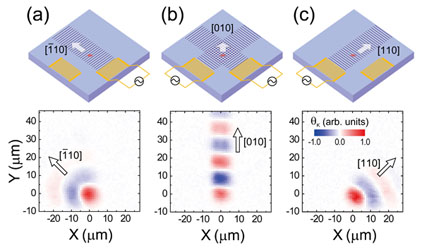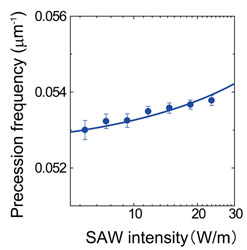Optical Science Laboratory, *Physical Science Laboratory
Transporting electron spins in semiconductors will be a crucial technique
both for fundamental research on spin-orbit interactions [1] and for the
spintronics applications that need spin information transfer [2]. We have
investigated the spin dynamics of electrons traveling with moving wires and dots formed by surface acoustic waves (SAWs) [3].
The moving wires and dots are generated in a 20-nm-thick GaAs/AlGaAs(001) quantum well (QW) grown
by molecular beam epitaxy. Interdigital transducers (IDTs) designed for
operation at a SAW wavelength of 2.55 µm were processed on the sample.
Depending on the IDT's direction, Rayleigh SAWs propagate along [-110]
or [110] with a velocity vSAW = 3 km/s. The single SAW beams produce moving wires, which are formed by the one-dimensional lateral confinement of the SAW-induced piezoelectric potential. The interference between the two orthogonal SAW beams forms moving dots traveling along [010] with a velocity of ![]() vSAW.
vSAW.
To measure the spin dynamics during transport, we employed Kerr microscopy
with a pump-probe technique. A circularly polarized pump light generated
spin-polarized electrons at a fixed position on the sample; and a linearly
polarized probe light, which can be scanned in the QW plane, was used to
detect the magneto-optic Kerr effect. Since the Kerr rotation angle θK is proportional to the spin density at the probe position, we can obtain
two-dimensional images of spin distribution under SAWs.
Figure 1 shows the two-dimensional images of the spin transport measured in the absence of an external magnetic field. For both moving wires and dots, we successfully extracted the precession behavior induced by the spin-orbit
interaction. We also found that the spin precession frequency for the moving dots depends on the SAW intensity (Fig. 2). The theoretical analysis of the
data revealed the existence of SAW-induced spin-orbit interactions, indicating
that the spin precession angle is acoustically tunable. These techniques
will provide the versatility needed for spin manipulation in future spintronics
applications.
This work was partly supported by KAKENHI.
[1] Y. Kato et al., Nature 427 (2004) 50.
[2] S. A. Wolf et al., Science 294 (2001) 1488.
[3] H. Sanada et al., Phys. Rev. Lett. 106 (2011) 216602.
 |
 |
|||||
|
|